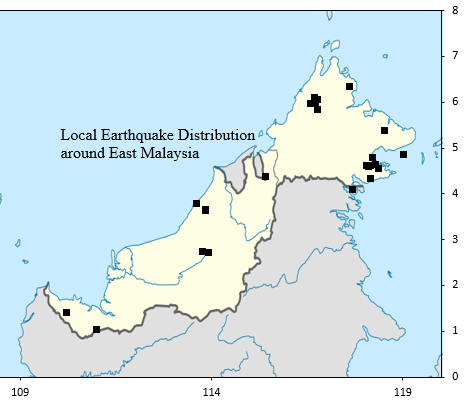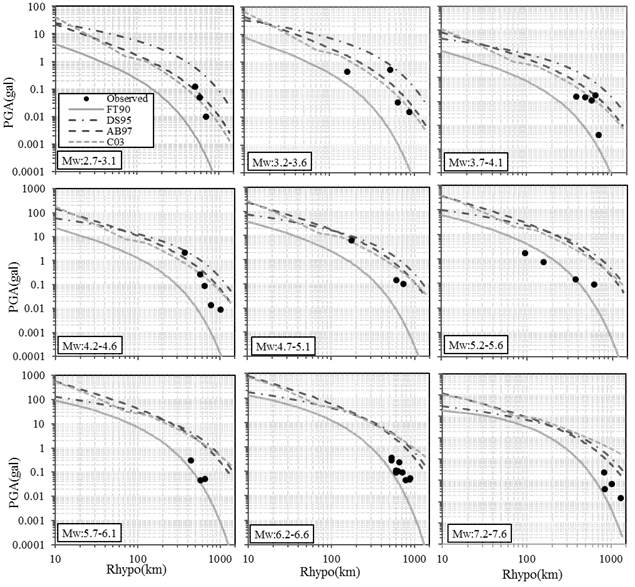-
Paper Information
- Next Paper
- Previous Paper
- Paper Submission
-
Journal Information
- About This Journal
- Editorial Board
- Current Issue
- Archive
- Author Guidelines
- Contact Us
Journal of Civil Engineering Research
p-ISSN: 2163-2316 e-ISSN: 2163-2340
2014; 4(3A): 120-123
doi:10.5923/c.jce.201402.20
The Compatible Ground-Motion Prediction Equations with East Malaysia for Shallow Crustal Earthquakes
Noor Sheena Herayani Harith1, 2, Azlan bin Adnan1, Abdollah Vaez Shoushtari1
1Faculty of Civil Engineering, Universiti Teknologi Malaysia, Johor Bahru, Malaysia
2School of Engineering and Information Technology, Universiti Malaysia Sabah, Kota Kinabalu, Sabah, Malaysia
Correspondence to: Noor Sheena Herayani Harith, Faculty of Civil Engineering, Universiti Teknologi Malaysia, Johor Bahru, Malaysia.
| Email: |  |
Copyright © 2014 Scientific & Academic Publishing. All Rights Reserved.
The common features in establish seismic design criteria for buildings, probabilistic seismic hazard analysis requires estimation of ground motion such as peak ground acceleration (PGA). This estimation process needs to use a ground motion prediction equation (GMPE) which provides PGA estimates incorporating a number of earthquake magnitude, distance and other seismic parameters. On the other hand, it is not always easy to assess inside GMPE since they mostly have all reliable parameters of ground motion records to develop a GMPE. Thus, the objective of this paper is to find the suitable existing models four international GMPEs that provide significant estimates at large source-to-site distance evaluated against comprehensive set of PGA compiled. The dataset of 41 observations of earthquake ground motions recorded provided by Malaysian Meteorological Department (MMD) specifically considered from earthquake with magnitude MW 2.9 to 7.3, fault distance from 10 to 1350 km were plotted and compared to the field records. It was found that the best fitting model of prediction equation proposed by Fukushima and Tanaka (1990) suitable for magnitude 5.0 and above whereas Atkinson and Boore (1997) and Campbell (2003) are suitable for magnitude less than 5.0.
Keywords: Ground motion prediction equation, Earthquake, East malaysia
Cite this paper: Noor Sheena Herayani Harith, Azlan bin Adnan, Abdollah Vaez Shoushtari, The Compatible Ground-Motion Prediction Equations with East Malaysia for Shallow Crustal Earthquakes, Journal of Civil Engineering Research, Vol. 4 No. 3A, 2014, pp. 120-123. doi: 10.5923/c.jce.201402.20.
Article Outline
1. Introduction
- A seismic hazard analysis is usually carried out to establish seismic design criteria for building and other critical structures such as nuclear power plant and dams. The analysis depends on the identification of the seismic sources and the estimation of their capacity to produce ground motions. The production of seismic hazard map for East Malaysia could be developed based on earthquake source zones identifiable from earthquake catalogs and ground motion estimation using current developed prediction equations.Ground motion prediction equation (GMPE) is essential in seismic hazard studies for estimating the ground motions generated by the seismic sources that rely on earthquake magnitude, source-to-site distance, and local site condition. In low seismicity regions, only weak motions are available and the equations selected for the probabilities studies are usually models established from foreign data. Although most ground motion prediction equations have been developed for magnitudes 5 and above, the smaller magnitude often used in probabilistic studies in low seismicity regions. The studies shows in [1] that the magnitude lower than 5 can be contributing to the earthquake hazard. East Malaysia had rarely experience large earthquake during the past few years. Since 1900 there have been two moderate earthquakes of shallow focal depths were recorded in Sarawak during year 1994 and 2004 of magnitude Mw 5.2. In Sabah, the historical records of moderate earthquakes caused substantial damage to buildings with two well-known event in 1976 and 1991 of magnitude Mw 5.8 and Mw 5.4, respectively. Even moderate magnitude of earthquake can be devastated when it destroyed many buildings and killed one third of the city’s population as happened in Morroco during 1960 [2]. Hence, there is a need for reliable predictions of ground motion equation over the whole magnitude range in low seismicity region such as East Malaysia.Prediction equation models developed from other regions of the world can be adopted if there is no reliable ground motion prediction equation as analyzed by many researchers [3-9]. The chosen of ground motion prediction equation must represent the geological and seismological attributes of the region with containing a wide range of magnitude and source-to-site distance. The prediction equation that suitable for stable continental region is implemented in this study to determine the most suitable attenuation function by comparing PGA estimates from four ground motion prediction equation to a number of records available from Malaysian Meteorological Department (MMD) recorded.
2. Ground Motion Data
- East Malaysia located on the island of Borneo and beside of affected by earthquakes located in the Straits of Macassar, Sulu Sea and Celebes Sea, this state also have experienced earthquakes from local origin faults that delineated over East Malaysia. In this study, the information of earthquake database is dependent on the data gathered by Malaysian Meteorological Department (MMD). After the devastating event of Sumatra earthquake on December 2004, Malaysian Meteorological Department (MMD) has installed the instrument recording on earthquake activities throughout Malaysia. The PGA values of earthquake data recorded by 26 stations around Malaysia has been corrected and filtered appropriately from year 2004 to 2012. The epicenter locations, date, time, and moment magnitudes of those 41 events of shallow crustal earthquakes were obtained from Harvard Central Moment Tensor Catalog (Fig. 1). The site conditions at the MMD recording stations are categorized into soil type B or rock site based on shear wave velocity in the top 30 meter of the ground (Vs30).
 | Figure 1. Earthquake events distribution map in East Malaysia |
 | Figure 2. Distribution of earthquake ground motion records used in this study (a) moment magnitude versus distance; and (b) peak ground acceleration versus distance |
3. Ground Motion Prediction Equation (GMPE)
- Various ground motion prediction equations (GMPE) that become available made it possible to choose the GMPE that suits East Malaysia region where each model is to be compared to the corresponding records. The analysis is carried out with four well-known GMPE models. The models were selected due to the criteria in magnitude and distance. The different type of distance measures are treated as hypocentral distance (Rhypo) together with the range of magnitude as shown in Table 1.
|
4. Comparison of Ground Motion Prediction Models and Recorded Data
- PGA estimated by attenuation models for East Malaysia regions are compared to actual records on rock sites as shown in Fig. 3. These actual earthquake recording were plotted into Mw=2.7 and 7.6 for comparison. Throughout all magnitude range, the attenuation functions except Fukushima and Tanaka [10] predicts large PGA than the observed PGAs. Although the Dahle et al. [11] attenuation function was to cover far-field and low magnitude earthquakes, it is over predicts the observed PGAs for magnitude less than 3.1 and give consistent trend of magnitude 3.2 and 5.1. The equation prediction by Atkinson and Boore [12] and Campbell [13] yield a similar trend with the recorded PGA for magnitude between 2.7 and 5.1 at longer distance. Among the four models, the Fukushima and Tanaka [10] gives the prediction equation rate for distance 10 – 1350 km and fits the observed data from magnitude 5.2 and above.
 | Figure 3. Comparison of attenuation curves with new developed attenuation models and recorded PGA for rock sites in East Malaysia from shallow crustal earthquakes |
5. Conclusions
- Based in the database used in this study, suitable ground motion prediction equation (GMPE) for estimating PGA on rock sites in East Malaysia due to shallow crustal earthquake are Atkinson and Boore [12] and Campbell [13] for magnitude less than 5.0 and Fukushima and Tanaka [10] for magnitude more than 5.0. The new GMPE specifically for East Malaysia could be developed if more earthquake data recorded from small to large magnitude at close distance are available.
ACKNOWLEDGMENTS
- This study was financially granted by Universiti Teknologi Malaysia (UTM) and Ministry of Science, Technology, and Innovation (MOSTI) of Malaysia. We thank the contributions of the Malaysian Metrological Department (MMD) for providing Sumatran earthquakes data used in this study.
 Abstract
Abstract Reference
Reference Full-Text PDF
Full-Text PDF Full-text HTML
Full-text HTML